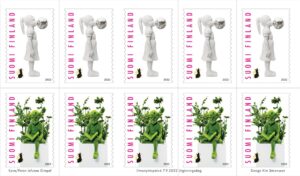Pekka Lempiäinen Suomen Filatelistiseurasta varoittaa Filatelistien Facebook-palstalla todennäköisistä väärennöksistä suomalaisissa uusissa postimerkeissä.
Kyseessä on ainakin vuoden 2022 arkki Postin taidepalkinto. Aito arkki on kuvassa 1.

Väärennöksen ehkä varmin tuntomerkki on teksti ”Ilmestymispaiva” arkin alareunassa, ilman ä:n pisteitä. Kuinka ollakaan, yksi epäilyttävä arkki näyttää olleen myynnissä huuto.net vertaiskauppapaikalla. Oikean ja väärän tekstin eroa esitetään seuraavassa kuvaparissa.

Suurennos ilmeisen väärennetystä tekstistä on myös otsikkokuvassa.
Arkin nimellishinta on 25 € (10 postimerkkiä), kun taas vertaiskauppapaikalla viittä kokonaista arkkia (50 kappaletta postimerkkejä) Kiinasta käsin kaupitellaan noin 13 € hintaan.
Lempiäisen mukaan lisätuntomerkkinä on väärennetyn paperilaatu. Sen voi tunnistaa hohtavan valkoisesta paperista. Samoin postimerkin vuosiluvun 2022 numeroitten etäisyys toisistaan poikkeaa aidosta.
Toinen vastaavan riskin kohde voi kuulemma olla Kansallisteatterin merkkipäivän kunniaksi 2022 tehty Juhlavuosia näyttämöllä. Kuvakaappaus Ebaystä alla.

Miten Posti reagoi?
Lähetin tiedon asiasta Postin X-tilille, kuvakaappauksen kera. Postin vastaus 7.2.2025: ”Hei. Tapaus on tiedossamme ja sitä selvitetään. Postimerkkien väärentäminen on rikos, joten asiassa edetään yhteistyössä viranomaisten kanssa.”
Tämä on nyt spekulaatiota, mutta rupesin pohtimaan, että onko Postilla paljoakaan keinoja tunnustaa väärennetty aidosta, siis jos merkin saa liimattua kuorelle yhtä hyvin kuin oikean? Nykyään kun tuntuu, että melkein millaisella banaanitarralla tahansa kuori voi kulkea perille.
Uusissa merkeissä olevan 2D-koodin luenta lajittelukeskuksessa ainakin periaatteessa voisi tunnistaa, jos väärennöksessä se ei ole täsmälleen oikeanlainen. Tai siis kopiointitilanteessa uudelleenkäytön yrityksen.Koodi tuli käyttöön vuonna 2023 (linkki).
Mihinkö tämä voisi johtaa? Siihenkö, että käyttämättömät postimerkit ilman 2D-koodia mitätöitäisiin? Tai siihen, että postimerkit korvataan numero- tai viivakoodeilla kokonaan (linkki)?
Kaikki vuoden 2022 postimerkkijulkaisut sekä ensipäivänkuoret on esitelty erikseen (linkki).
Pekka Lempiäinen from the Finnish Philatelic Society warns on the Philatelists’ Facebook page about probable forgeries in new Finnish stamps.
This is at least the 2022 sheet of the ”Postin taidepalkinto” (Art Prize). The genuine sheet is in fig. 1.

Perhaps the surest sign of a forgery is the text ”Ilmestymispaiva” (”date of issue”) at the bottom of the sheet, without the dots in the letter ”ä”. Be that as it may, one suspicious sheet seems to have been for sale on the huuto.net peer-to-peer marketplace. The difference between the correct and incorrect text is shown in the following pair of figures.

An enlargement of the obviously forged text is also in the title picture of this blog.
The nominal price of the sheet is €25 (10 stamps), while on a peer-to-peer marketplace, five complete sheets (50 stamps) from China are being sold for around €13.
According to Lempäinen, an additional telltale sign is the quality of the paper used to make the fake. It can be identified by the shiny white paper. Similarly, the distance between the numbers in the year 2022 on the stamp differs from the real one.
Another target of a similar risk may reportedly be the ”Juhlavusia näyttämöllä” stamp sheet, made in honor of the National Theatre’s anniversary in 2022. Figure caption from Ebay below.

How will Finnish postal company Posti react?
I sent information about the matter to Posti’s X account, with a screenshot. Posti’s response on February 7, 2025: ”Hello. We are aware of the incident and are investigating it. Counterfeiting stamps is a crime, so we are proceeding with the matter in cooperation with the authorities.”
This is speculation now, but I started to wonder if Posti has any ways to recognize a fake from a real one, that is, if the stamp can be glued to the envelope as well as the real one? Nowadays, it seems that almost any banana sticker can get the envelope to its destination.
Reading the 2D code on the new stamps at the sorting center could, at least in principle, identify if it is not exactly the right one in a counterfeit. Or in a case of copying, an attempt at reuse. The 2D-code came into use in 2023 (link).
What could this lead to? That unused stamps without a 2D code would be invalidated? Or that stamps would be replaced with numeric or barcode codes entirely?
All 2022 stamp issues and first day covers are presented separately (link).

